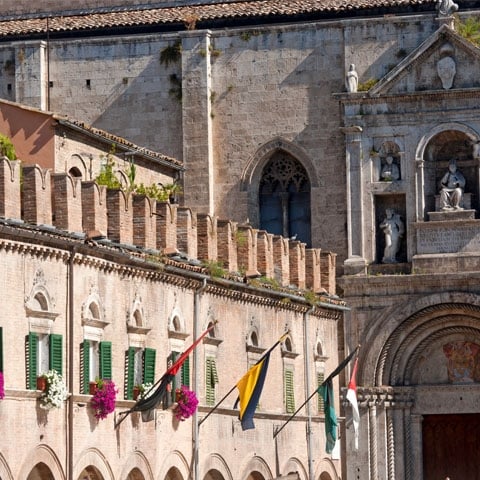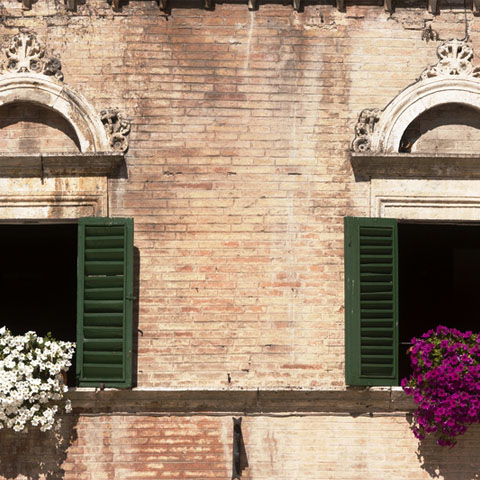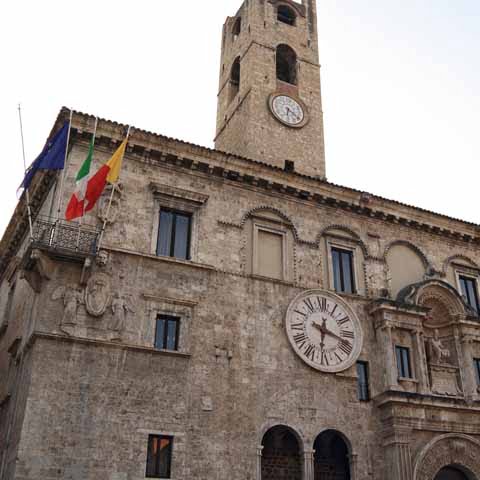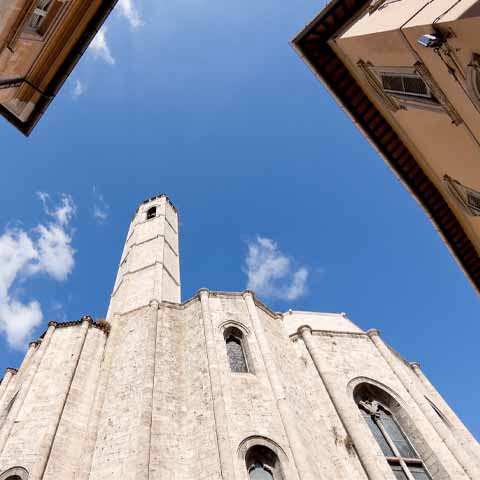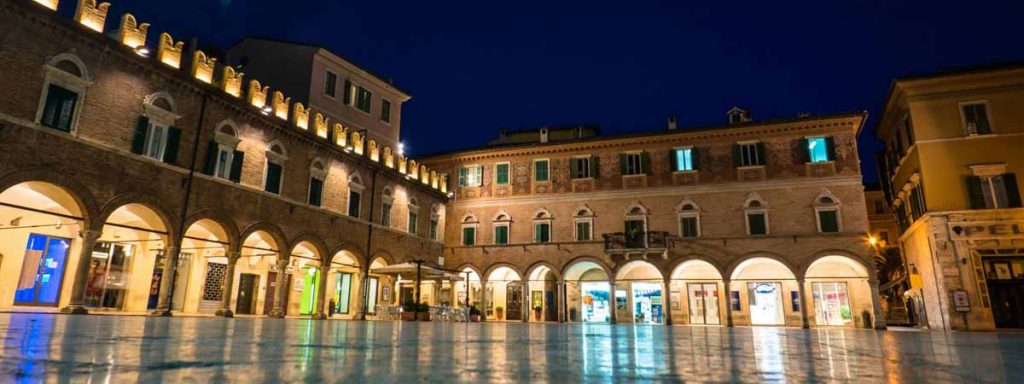Centrally located near the east coast of Italy is the charming picturesque city of Ascoli Piceno. This small city in the Marche region is somewhat less traveled than many of its counterparts because of its size, making Ascoli Piceno a true joy to tour and explore without large crowds. Let the architecture, art, and natural beauty of this adorable Italian city sweep you off your feet with an enchanting visit that will only leave you wanting more.
ARCHITECTURE
When it comes to architecture, one of the best places to visit in Ascoli Piceno is the historic Piazza Arringo. This ancient square is paved with travertine and is surrounded by important historical landmarks such as Duomo of Sant’Emidio, the Baptistery of San Giovanni, Palazzo Panichi, and Palazzo dell’Arengo, just to name a few. With the square often being a social and political gathering place for the people, it makes sense to have this magnificent collection of buildings surrounding it.
Not to be outdone is Piazza del Popolo which features grand buildings such as the Merchant’s Lodge, and Palazzo dei Capitani del Popolo (the former Town Hall). This square features a number of beautiful porticoes and columns that make strolling the square a joy in any weather.
Inside and outside of the main piazze, churches abound here in the city of Ascoli Piceno. The area has a rich religious tradition and many of the churches have roots that trace back to patron saints and other important religious icons.
The Basilica of San Francesco is a beautiful gothic style church that sits on the Piazza del Popolo. The exterior is beige in color and features one green dome and one bell tower. Much of the structure was built in the late fourteenth century with some additions, such as the bell tower, established as late as the fifteenth century. In true Ascoli Piceno style, travertine marble is incorporated into the basilica. The interior features one main aisle with intricately detailed ceilings and grand archways. The seventeenth century travertine pulpit inside was designed by Antonio Giosafatti and is not to be missed.
The Duomo of Sant’Emidio is one of the most visited churches of Ascoli Piceno. The church is dedicated to the first Bishop of Ascoli who is also the patron saint of the city and is said to protect the town against damaging earthquakes. The exterior of the church is off-white in color and has one bell tower. The interior of the church is home to a number of pieces of art including relics of Sant’Emidio and an altar made by a historic local artist, Carlo Crivelli.
Several smaller beautiful and historic churches can be found around town. Some of these religious buildings include the Church of San Vittore, the Church of San Tommaso Apostolo, and the Church of San Pietro Martire. Each shines in its own way through history, art, or a delightful combination of the two.
For a piece of architecture that is not tied to religion, make it a point to visit Porta Solestà, a well-known bridge in the city. The bridge was originally built to connect two shores of the Tronto River and by default two Roman provinces. The bridge is over two hundred feet long, features an arched entryway, and is mostly comprised of travertine.
Outside of the historic city center, it is possible to visit the Malatesta Fortress, which is one of the important examples of Renaissance defensive architecture in Italy. While the original structure dates back to Pre-Roman times, the fortress was actually destroyed and rebuilt several times over the centuries. The name of the fortress can be traced to Galoetto Malatesta, who reinforced the structure as a medieval fortress. Today the fortress serves as a venue for temporary art exhibitions and it is also the home of the Museum of the Late Medieval Period.
One of the city’s nicknames is “The City of 100 Towers.” Although towers were estimated to once cover the area, it is thought that Frederick II may have played a role in the demolishing of many. Combined with the deterioration of time, sadly only approximately fifty towers remain visible today. Be sure not to leave the city before visiting a few of these towers to enjoy and appreciate the longevity of these tall structures and the history behind them.
ART
Several renowned Italian painters such as Domenico Balestrieri, Carlo Crivelli, Girolamo Buratti, and Dino Ferrari were from Ascoli Piceno. Crivelli was a fifteenth century artist who painted mostly religious images. Buratti was a sixteenth century artist known for painting the Presepio at a local church. Ferrari was a twentieth century painter whose work is displayed throughout the city, including Veduta del Salone della Vittoria, Veduta di paese, and Figura di donna. Work by many of these artists can be admired at Ascoli Piceno’s Pinacoteca Civica, or Civic Art Gallery.
For more recent art, head to the Osvaldo Licini Contemporary Art Gallery. On display are works by the museum’s namesake, Osvaldo Licini, as well as other important Italian contemporary artists, such as Lucio Fontana, Filippo de Pisis, Gino Severini, Roberto Matta, and more.
LITERATURE
Twelfth and thirteenth century poet Cecco d’Ascoli was born in the small town of Ancarano near Ascoli Piceno. Cecco d’Ascoli is best known for his encyclopedic poem entitled Acerba, which chronicled contemporary tenets of natural science.
MUSIC
A native of Ascoli Piceno, Mariano Detto is a twentieth and twenty-first century Italian composer of many talents. Detto also arranges music and is considered a lyricist and pianist. In addition to composing music for many film soundtracks, Detto is credited with collaborating with renowned artists such as Mario Del Monaco, Lucio Battisti, and Adriano Celentano, just to name a few.
The Ventidio Basso Theater is home to a variety of concerts and opera music for locals and visitors alike to enjoy. The theater sits near the Piazza del Popolo. In the mid-nineteenth century, the theater was home to operatic performances such as I puritani and Ernani, both of which are said to have starred renowned soprano Anna de La Grange. The theater is one of the small town’s most important historical landmarks.
CINEMA
Screenwriter Giuseppe Piccioni was born in Ascoli Piceno in the mid-twentieth century. His writing has given birth to approximately ten films thus far, some of which were nominated to international film festivals. Some of the films Piccioni has written and directed include La vita che vorrei (2004), Giulia non esce la sera (2009), Il rosso e il blu (2012), and Questi giorni (2016). Piccioni’s 1987 movie Il grande Blek and his 1996 movie Cuori al verde were both filmed in Ascoli Piceno.
The unique make up of much of the city, a type of limestone called travertine, makes it a one-of-a-kind background when it comes to the big screen. Add to that the surrounding beauty of greenery and beautiful rivers, and the lure for bringing filming for a movie here substantially increases. One of the more prominent Italian pictures filmed here is Fracesco Maselli’s I Delfini (1960) starring Gerard Blain and Claudia Cardinale. Rather than just one scene, much of the movie is filmed in various parts of the city. Much of Pietro Germi’s 1972 Italian film, Alfredo, Alfredo was also filmed in the area.
Other films set in Ascoli Piceno include Peccato senza malizia (1975), Morirai a mezzanotte (1986), and L’eretico – Un gesto di coraggio (2005).
SCIENCE
Ascoli Piceno is home to Hub21, a scientific, technological, and cultural research center. The center was founded to support the innovation and development of startups.
Ascoli Piceno, located in the tranquil Marche region of Central Italy, is a wonderful place to get to know the country outside of its most famous cities. Ascoli Piceno offers fascinating historic monuments, such as the Duomo of Sant’Emidio, that captivate travelers from all over the world.Travel Guides
The Marche Region of Italy
The Cities of Marche, Italy
